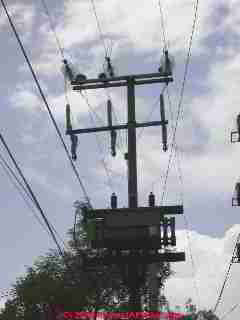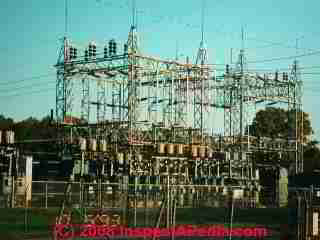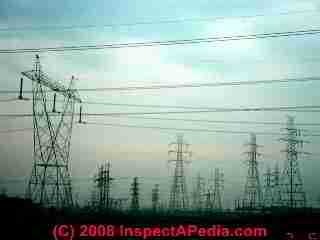 Effects of Power Line or other Source Distance on EMF Strength Measurements
Effects of Power Line or other Source Distance on EMF Strength Measurements
- POST a QUESTION or COMMENT about the effect of distance from power lines or other EMF (or RF) sources on field strength & exposure
Effects of EMF exposure as a function of distance from the power transmission line or other source of electromagnetic fields: an easy-to-understand summary.
This paper discusses the effect of distance from a power transmission line (or other EMF sources) when performing electromagnetic field (EMF) or electro-magnetic radiation EMR measurements to measure EMF exposure levels in gauss or milligauss.
We discusses sources of error and variation in EMF measurements and we review and make suggestions for using several low-cost EMF measurement devices to determine the instantaneous electromagnetic field exposure.
InspectAPedia tolerates no conflicts of interest. We have no relationship with advertisers, products, or services discussed at this website.
- Daniel Friedman, Publisher/Editor/Author - See WHO ARE WE?
EMF strength effects and distance from the electromagnetic field source
 The strength of an electromagnetic field diminishes as the square of the distance one is from the power line or field
source. So in general, walking closer to a power transmission line will give a higher reading.
The strength of an electromagnetic field diminishes as the square of the distance one is from the power line or field
source. So in general, walking closer to a power transmission line will give a higher reading.
But near a large power transmission line, since the electrical field has a "shape" and since a building owner's property line may not be exactly parallel to the power transmission lines themselves, I've found that field strengths along a line parallel to the edge of a property may vary widely.
At our little decimal point demonstration at see Comparing Gauss versus Milligauss Field Strength Measurements where we explain the greater accuracy of low-level EMF readings when using the milligauss scale on an ELF EMF meter, you can see a measurement of about 25 milligauss obtained when the instrument was touching a 120VAC to 12VDC power converter that draws about 1Amp.
But if we move the instrument just a single foot away we will probably not detect this field whatsoever. That's why, unless you sleep with your electric clock right next to your head, you are probably not going to be affected by its electrical field.
The electromagnetic field produced by a step-down electrical power transformer on a local electrical system distribution utility pole such as the one shown in our photo at left can be measured easily from the street below the pole.
If the power transformer is just a meter or two outside of a bedroom window, it's likely that one can measure this electrical field inside. At greater distances it's not likely that you can detect this effect.
Power transmission facility design also affects the strength of the EMF generated.
Load or phase balancing for overhead transmission lines, distance between electrical conductor wires, and the choice to use buried transmission lines (which are much more costly to install) can make a very significant difference in the measurable EMF.

Distances from power lines and EMF field strength: The distances for common field strengths and power lines are available in a number of EPA documents, such as "Evaluation of the Potential Carcinogenicity of Electromagnetic Fields," EPA/600/6-90-005B October 1990 (DRAFT review copy), page 2-21.
For example, the field strength of a 500 KV Transmission line begins to fall off measurably at 50 meters, but does not fall off below 1 mG until distances nearing 1000 meters.
Keep in mind that independent of proximity to power transmission facilities, a careful survey of conditions in any building may reveal other devices like home appliances or electrical service entry cabling: areas where strong EMF can be measured from distances of a few inches to several feet away.
Also keep in mind that based on our own field experience, we note that it would be unusual in any urban or suburban environment to find ambient EMF levels below one or two milligauss.
EMF strength variation and seasonal or time of day variations in electrical power usage levels
But distance from the power transmission line, while important, is not the only important factor. The strength of the electromagnetic field varies dramatically as the current passing through the power line varies.
Thus in the middle of summer in the Northeastern United States, when many people are running air conditioners and thus the load on the electrical grid is high, a lot of current is passing through the power transmission lines, and the EMF strength will be quite high - thus extending further from the power lines and being measurable at higher levels than it will during times of low electricity usage. Therefore no single instantaneous EMF measurement at a particular spot may be quite repeatable.
A power transmission company can tell you the kilovoltage that a given transmission line is designed to carry. This is not enough data to calculate exposure or risk. One would need to know the actual minute-to-minute load on the transmission line to be able to predict the probable EMF strength during those intervals.
The absence of this data has plagued attempts to correlate proximity to power transmission lines, EMF exposure, and health risks. The "Swedish study" mentioned herein was able to overcome this difficulty and obtain actual usage data and thus was able to calculate the actual EMF exposure levels.
Often but not always, the relative strength of such fields falls off in much shorter distance than that from power transmission facilities. However in some instances where occupants wish to maintain prudent avoidance, it is possible to make a significant reduction in exposure by small changes in arrangement of devices or locations of working or sleeping areas.
Power companies in the US have been singularly uncooperative in providing actual load data, making it difficult to establish a dose-exposure relationship between exposure to EMF and occurrence of disease. This is why the Swedish studies are so important. There the government cooperated with researchers in providing load data, permitting clear establishment of exposure to occurrence relationships.
Instead of contacting us with a request to perform EMF Electromagnetic or RF Radio Frequency Field Strength measurements, in most cases it is more economical and convenient for a property owner to purchase their own instrument, making measurements under varying conditions. In this series of articles we describe how to make measurements using a consistent approach and using good documentation. See Recommended EMF Measurement Procedure for details of how to collect EMF measurement data.
Following good procedure and using instruments properly are two steps towards making accurate, repeatable EMF measurements. But because the signal transmission for RF sources such as radio, TV, or cell towers, the load on a power transmission line is not under control of an individual property owner, and because the EMF strength varies as the power transmission line load varies, it is important to have an idea of that condition as well when attempting to characterize EMF exposure at a specific location.
In contrast, EMF measurements are quite accurate and repeatable at other EMF sources such as close to electrical appliances and service entry cables.
Please do not contact us with a request buy EMF or RF measuring equipment. We do not sell anything. To do so would be a conflict of interest for this website. These devices are readily available from many electrical equipment and home inspection equipment suppliers. See Evaluation of Low-Cost EMF Instruments
This article describes several low-cost and reasonably accurate EMF measurement devices that are readily available. See Radio Frequency RF Detection Meters This article describes several low-cost and accurate radio frequency or RF detection and measurement devices suitable for radio, TV, cellphone, microwave, and similar signals.
The information provided here is for research and study purposes. The author makes no representation of unique expertise on this topic, other than having field experience in EMF measurement, having studied technical literature and having conversed with other experts and authors in the field for a number of years.
...
...
Continue reading at EMF MEASUREMENT INSTRUMENTS or select a topic from the closely-related articles below, or see the complete ARTICLE INDEX.
Or see these
Recommended Articles
- CELL PHONE RADIATION
- DEFINITIONS of EMF RF FIELD & FREQUENCY
- DEFINITIONS of HERTZ, KHz MHz GHz THz
- ELECTROMAGNETIC FIELD EMF ELF & RF DETECTION
- EMF ELECTROMAGNETIC FIELDS & HUMAN EXPOSURE
- EMF CANCER SCARE
- EMF CANCER RISK
- EMF/EMR MEASUREMENT OVERVIEW
- EMF HAZARD & MEASUREMENT REFERENCES
- EMF LOCAL SOURCES MAY EXCEED POWER LINE STRENGTH
- EMF MEASUREMENT DISTANCE AFFECTS STRENGTH
- EMF MEASUREMENT INSTRUMENTS
- EMF MEASUREMENT INSTRUMENT ACCURACY
- EMF MEASUREMENT INSTRUMENT USE TIPS
- EMF MEASUREMENT PROCEDURES
- EMF MEASUREMENT STEP BY STEP
- EMF SURVEY PROCEDURE
- EMF SURVEY REPORT INTERPRETATION
- EMF WORKSHEET for EMF MEASUREMENTS
- EMF WORKSHEET Example
- EMF WORKPLACE EXPOSURE
- ENVIRONMENTAL HAZARDS at BUILDINGS - home
- RF RADIO FREQUENCY DETECTION METERS
Suggested citation for this web page
EMF MEASUREMENT DISTANCE AFFECTS STRENGTH at InspectApedia.com - online encyclopedia of building & environmental inspection, testing, diagnosis, repair, & problem prevention advice.
Or see this
INDEX to RELATED ARTICLES: ARTICLE INDEX to BUILDING ENVIRONMENT
Or use the SEARCH BOX found below to Ask a Question or Search InspectApedia
Ask a Question or Search InspectApedia
Try the search box just below, or if you prefer, post a question or comment in the Comments box below and we will respond promptly.
Search the InspectApedia website
Note: appearance of your Comment below may be delayed: if your comment contains an image, photograph, web link, or text that looks to the software as if it might be a web link, your posting will appear after it has been approved by a moderator. Apologies for the delay.
Only one image can be added per comment but you can post as many comments, and therefore images, as you like.
You will not receive a notification when a response to your question has been posted.
Please bookmark this page to make it easy for you to check back for our response.
IF above you see "Comment Form is loading comments..." then COMMENT BOX - countable.ca / bawkbox.com IS NOT WORKING.
In any case you are welcome to send an email directly to us at InspectApedia.com at editor@inspectApedia.com
We'll reply to you directly. Please help us help you by noting, in your email, the URL of the InspectApedia page where you wanted to comment.
Citations & References
In addition to any citations in the article above, a full list is available on request.
- "Questions and Answers about Biological Effects and Potential Hazards of Radiofrequency Electromagnetic Fields", Federal Communications Commission, Office of Engineering and Technology, US FCC, OET Bulleting 56, 4th Edition, August 1999
" Many consumer and industrial products and applications make use of some form of electromagnetic energy. One type of electromagnetic energy that is of increasing importance worldwide is radiofrequency (or "RF") energy, including radio waves and microwaves, which is used for providing telecommunications, broadcast and other services. In the United States the Federal Communications Commission (FCC) authorizes or licenses most RF telecommunications services, facilities, and devices used by the public, industry and state and local governmental organizations. Because of its regulatory responsibilities in this area the FCC often receives inquiries concerning whether there are potential safety hazards due to human exposure to RF energy emitted by FCC-regulated transmitters. Heightened awareness of the expanding use of RF technology has led some people to speculate that "electromagnetic pollution" is causing significant risks to human health from environmental RF electromagnetic fields. This document is designed to provide factual information and to answer some of the most commonly asked questions related to this topic." - original source: U.S. Federal Communications Commission Office of Engineering and Technology, http://www.fcc.gov/Bureaus/Engineering_Technology/Documents/bulletins/oet56/oet56e4.pdf
CONTINUE READING or RECOMMENDED ARTICLES.
- Carson, Dunlop & Associates Ltd., 120 Carlton Street Suite 407, Toronto ON M5A 4K2. Tel: (416) 964-9415 1-800-268-7070 Email: info@carsondunlop.com. Alan Carson is a past president of ASHI, the American Society of Home Inspectors.
Thanks to Alan Carson and Bob Dunlop, for permission for InspectAPedia to use text excerpts from The HOME REFERENCE BOOK - the Encyclopedia of Homes and to use illustrations from The ILLUSTRATED HOME .
Carson Dunlop Associates provides extensive home inspection education and report writing material. In gratitude we provide links to tsome Carson Dunlop Associates products and services.

